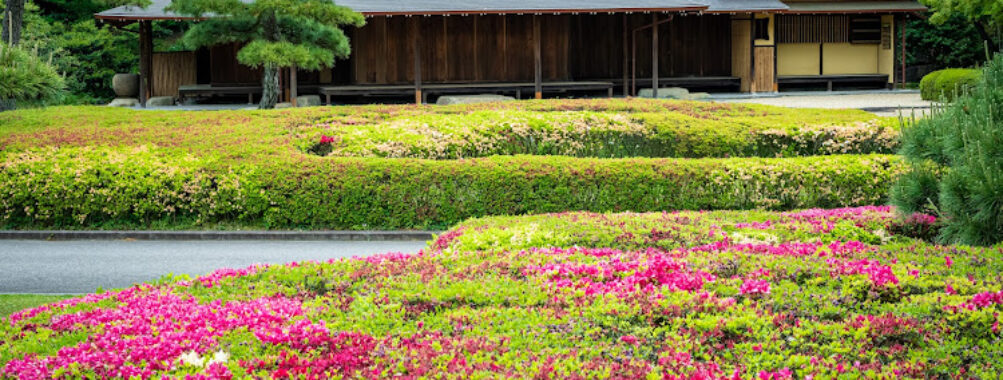
Ninomaru Garden
Table of Contents
Description
Step into the enchanting world of Ninomaru Garden, a masterpiece of Japanese landscape design that’s been captivating visitors since 1636. This historic garden, [designed by renowned landscape architect and tea master Kobori Enshu](https://www.theblissfulgardeners.com/ninomaru-garden/), stands as a testament to the refined aesthetics of Edo-period Japan. The garden’s centerpiece is a magnificent pond where colorful koi fish glide beneath the surface, surrounded by meticulously placed stones and carefully pruned greenery that create a perfect harmony of natural elements.
Key Features
• Central pond featuring three symbolic islands: [Hōrai-jima (Island of Eternal Happiness), Tsuru-jima (Crane Island), and Kame-jima (Turtle Island)](https://www.theblissfulgardeners.com/ninomaru-garden/)
• Traditional stone lanterns and bridges that create picture-perfect photo opportunities
• Seasonal flowers and plants that transform the garden throughout the year
• Ancient stone walls and fortified gateways that hint at the garden’s imperial past
• Peaceful walking paths that wind through various garden sections
• Strategically placed benches for quiet contemplation
• Crystal-clear streams and mini waterfalls
• Native Japanese plant species including maple trees and cherry blossoms
Best Time to Visit
Each season paints Ninomaru Garden in different colors, making it a year-round destination. Spring brings the famous cherry blossoms, painting the garden in delicate pink hues. Summer sees the garden at its lushest, with deep greens and blooming water lilies in the pond. Fall transforms the maple trees into a spectacular display of reds and golds. Even winter has its charm, with frost-covered stones and bare branches creating an elegant minimalist landscape.
Morning visits often provide the most serene experience, as the early light filters through the trees and morning mist sometimes hovers over the pond. I’ve found that arriving right when the garden opens lets you experience its tranquility before the crowds arrive.
How to Get There
The garden sits within the East Gardens of the Imperial Palace complex, making it easily accessible by public transportation. The closest subway stations are Otemachi Station and Takebashi Station, both about a 5-minute walk from the entrance. Y’know what’s cool? The garden is actually free to enter – a rare treat in Tokyo! Just remember they’re closed on Mondays and Fridays, unless it’s a public holiday.
Tips for Visiting
Look, I’m gonna level with you – this isn’t your typical tourist spot where you can just rush through snapping photos. To really appreciate Ninomaru Garden, you’ll want to take your time. Here are some insider tips I’ve gathered from multiple visits:
Bring a water bottle and some snacks – there’s limited food options nearby. You might want to pack a small towel too, especially during humid summer months. The garden can get pretty toasty!
Photography enthusiasts, bring your wide-angle lens – trust me on this one. The garden’s layout offers some amazing compositional opportunities, especially around the pond area. But please be mindful of other visitors when setting up your shots.
Wear comfortable walking shoes – the paths are well-maintained but you’ll be doing quite a bit of walking. And if you’re visiting during rainy season (June-July), an umbrella isn’t a bad idea.
Time your visit around the crowds – mid-afternoon tends to be busiest, especially on weekends. Early mornings or late afternoons are usually quieter, giving you more space to explore and reflect.
Keep an eye on the weather forecast. After rain, the garden takes on a whole different character – the moss looks greener, the stones shine, and the air feels fresher. But some paths can get a bit slippery, so watch your step.
Oh, and here’s something most guidebooks won’t tell you – the best spot for viewing the entire garden layout is from the slight elevation near the northern edge. It’s a bit off the main path, but totally worth finding.
Remember, this isn’t just any garden – it’s a living piece of Japanese history that’s survived centuries. Take time to notice the little details: the way stones are arranged, how water flows through the streams, and how each plant contributes to the overall composition. Every element has been thoughtfully placed to create a harmonious whole.
Location
Places to Stay Near Ninomaru Garden
Find and Book a Tour
Explore More Travel Guides
No reviews found! Be the first to review!